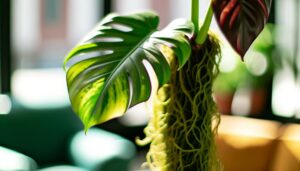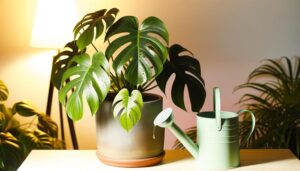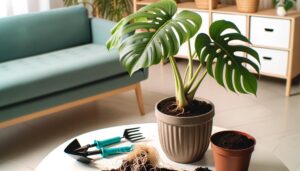Caring for an Monstera Dubia? Essential Care Guide!
To care for your Monstera Dubia, make sure it gets bright, indirect light from a north or east-facing window, or supplement with grow lights. Keep the soil moist and well-draining, allowing the top inch to dry slightly between waterings.
Maintain humidity between 60-80% using a humidifier or misting regularly. Fertilize every 4-6 weeks with a diluted 20-20-20 water-soluble fertilizer.
For propagation, use stem cuttings with at least one node. You’ll address nutrient deficiencies and pest issues by ensuring sufficient humidity and air circulation.
Learn about pruning techniques and common pests ahead.
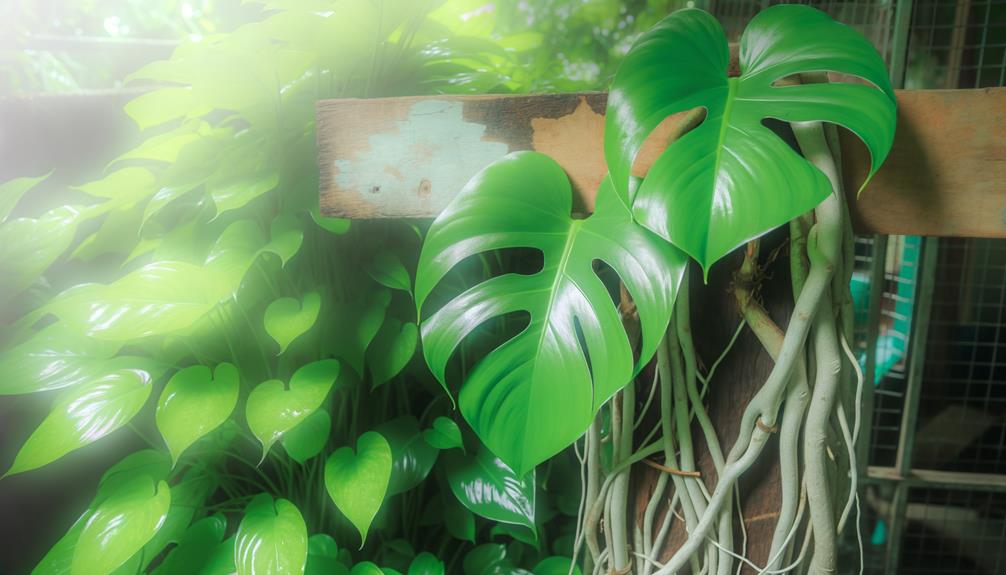
Key Takeaways
- Place the plant in bright, indirect light, avoiding direct sunlight.
- Keep soil consistently moist and well-draining, allowing the top inch to dry slightly between waterings.
- Maintain humidity levels between 60-80% using a humidifier or misting.
- Fertilize every 4-6 weeks with a diluted 20-20-20 water-soluble fertilizer.
- Propagate using stem cuttings with at least one node, placing them in water or soil.
Optimal Lighting Conditions
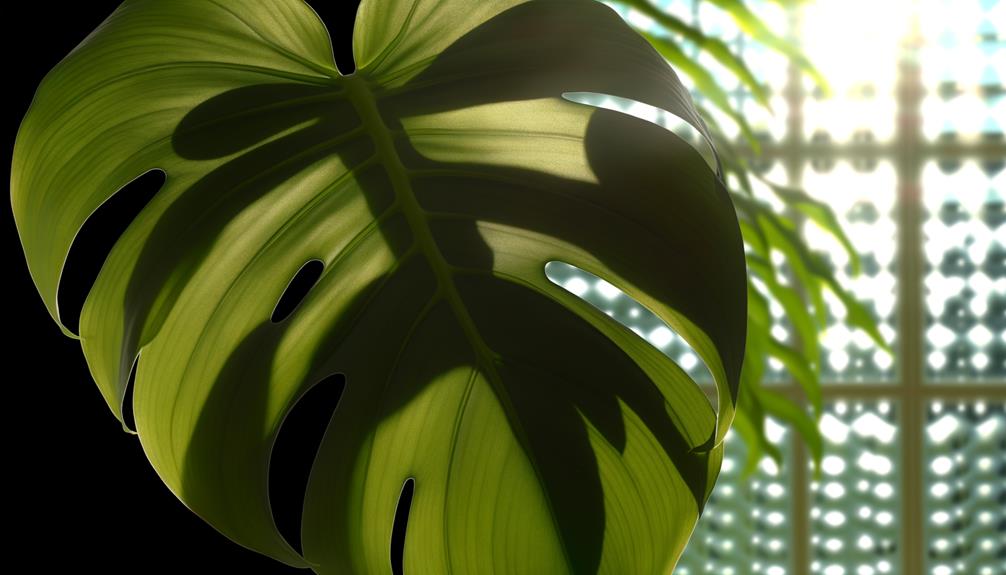
To maximize your Monstera Dubia’s growth, provide it with bright, indirect light to mimic its natural understory habitat. Place your plant near a north or east-facing window where it receives filtered sunlight. Direct sunlight can scorch its delicate leaves, leading to chlorosis and stunted growth.
If natural light is inadequate, use a grow light with a full spectrum to replicate daylight. Maintain a light intensity of 10,000 to 20,000 lux for ideal photosynthesis. Rotate the plant periodically to promote even light distribution and prevent phototropism.
Monitor the leaf color and growth patterns; pale leaves indicate excessive light, while leggy growth suggests insufficient light. Proper lighting encourages healthy chlorophyll production, ensuring strong growth and vibrant foliage.
Watering Guidelines
Ensuring proper hydration for your Monstera Dubia involves understanding its preference for consistently moist but well-draining soil. Water your plant thoroughly until water exits the drainage holes, ensuring the entire root system is hydrated.
Avoid waterlogging by allowing the top inch of soil to dry slightly between waterings. Overwatering can lead to root rot, compromising the plant’s vascular system. To gauge moisture levels, insert your finger into the soil; if it feels dry, it’s time to water.
Monstera Dubia prefers high humidity, around 60-80%, so misting the leaves or using a humidifier can be beneficial. Monitor for signs of underwatering, such as wilting or browning leaf edges, and adjust your watering schedule accordingly.
Soil Requirements
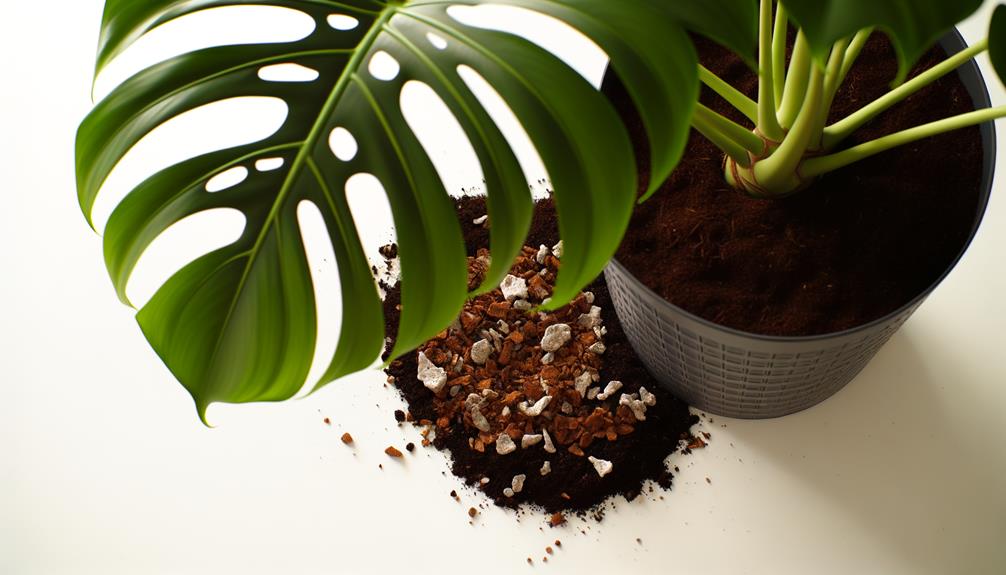
When caring for your Monstera Dubia, you’ll need a soil mix that’s well-aerated and rich in organic matter, ensuring ideal root health and proper drainage. A balanced blend of peat moss, perlite, and orchid bark works well. This mix mimics the plant’s natural habitat, promoting robust root growth and preventing waterlogging, which can lead to root rot.
| Ingredient | Proportion | Benefits |
|---|---|---|
| Peat Moss | 40% | Retains moisture, nutrients |
| Perlite | 30% | Enhances aeration, drainage |
| Orchid Bark | 30% | Promotes root oxygenation |
Ensure your soil mix is light and airy, allowing roots to breathe. Regularly check for compaction and refresh the mix annually to maintain soil quality and plant vigor.
Ideal Humidity Levels
To maximize your Monstera Dubia thrives, you’ll need to maintain an ideal humidity range of 60-80%. Use a hygrometer to monitor humidity levels and consider a humidifier or regular misting to keep the environment stable.
Look for signs of low humidity, such as browning leaf edges or slowed growth, to adjust your care routine accordingly.
Optimal Humidity Range
Maintaining a perfect humidity range of 60-80% is crucial for the healthy growth and development of Monstera Dubia. This plant thrives in high humidity environments, mimicking its native tropical habitat. Elevated humidity levels enhance the plant’s transpiration process, facilitating nutrient uptake and photosynthesis.
To achieve this, you should monitor the relative humidity in the plant’s vicinity.
Here are key physiological benefits of maintaining peak humidity:
- Enhanced stomatal function: Ensures efficient gas exchange and water regulation.
- Reduced transpiration stress: Prevents leaf desiccation and curling.
- Improved nutrient absorption: Boosts root efficiency in nutrient uptake.
- Increased growth rate: Promotes vigorous foliage and root development.
- Disease resistance: High humidity helps the plant fend off pests and pathogens.
Understanding these benefits underscores the importance of maintaining the peak humidity range for your Monstera Dubia.
Humidity Maintenance Tips
Achieving the perfect moisture levels for Monstera Dubia involves using tools like hygrometers to monitor dampness and employing methods such as misting, using humidity trays, or deploying humidifiers. Aim to maintain moisture levels between 60% and 80%. Use a hygrometer to regularly check ambient moisture.
If levels drop, you can mist the leaves lightly, making sure water droplets don’t accumulate and cause fungal issues. A moisture tray, placed beneath the plant, can provide a steady moisture source. Alternatively, a humidifier placed nearby maintains consistent air moisture. Ensure good air circulation to prevent mold and pests.
Understanding Monstera Dubia’s natural tropical habitat helps replicate conditions, promoting prime growth and physiological health.
Signs of Low Humidity
When humidity levels fall below the optimal range of 60% to 80%, your Monstera Dubia will display signs such as browning leaf edges, curling leaves, and slowed growth. Recognizing these symptoms early can help you take corrective action. Low humidity affects the plant’s ability to transpire efficiently, resulting in reduced water uptake.
Be on the lookout for:
- Browning leaf margins: indicating desiccation stress.
- Leaf curling: a defensive mechanism to reduce surface area and minimize water loss.
- Stunted growth: due to insufficient cellular turgor pressure.
- Leaf drop: as the plant sheds stressed foliage.
- Reduced aerial root development: impacting its ability to climb and sustain itself.
Addressing low humidity promptly will guarantee your Monstera Dubia remains vibrant and healthy.
Fertilizing Schedule

To guarantee your Monstera Dubia flourishes, apply a balanced, water-soluble fertilizer every four to six weeks during the growing season. Use a 20-20-20 or similar formulation, diluted to half its recommended strength.
This maximizes an even supply of essential nutrients like nitrogen (N), phosphorus (P), and potassium (K), promoting vigorous leaf growth and root development.
Administer fertilizer directly to the soil, avoiding foliage contact which could cause burns. Ensure the soil is moist before application to prevent root damage.
Monitor your plant for nutrient deficiencies, such as yellowing leaves, and adjust your fertilizing schedule accordingly. Over-fertilizing can lead to salt build-up, so flush the soil periodically with water to maintain prime plant health.
Pruning Techniques
Pruning your Monstera Dubia involves removing any dead or yellowing leaves to encourage healthy growth and prevent disease. Start by sterilizing your pruning shears to avoid introducing pathogens. Trim back to the nearest healthy node, ensuring you make clean cuts. This will help the plant allocate resources more efficiently.
Here are key tips for effective pruning:
- Inspect regularly: Check your plant weekly for any signs of decay or discoloration.
- Cut at an angle: Make angled cuts to promote faster healing.
- Avoid over-pruning: Remove no more than 20% of the plant at a time.
- Prune during the growing season: Ideally, prune in spring or summer when the plant is most vigorous.
- Dispose properly: Safely discard pruned material to prevent disease spread.
Common Pests and Diseases

You’ll need to watch out for common pests like spider mites, scale insects, and mealybugs that can infest your Monstera Dubia and cause significant damage.
Spider mites create webbing on leaves, leading to stippling and discoloration.
Scale insects latch onto stems and leaves, secreting a sticky honeydew that promotes sooty mold growth.
Mealybugs hide in leaf axils, appearing as white, cottony masses and sucking sap, which weakens the plant.
To combat these pests, use a cotton swab dipped in rubbing alcohol to remove them manually.
For severe infestations, apply insecticidal soap or neem oil, ensuring thorough coverage of both sides of the leaves.
Maintain proper humidity and air circulation to deter pest proliferation, as a healthy environment is essential for your Monstera Dubia’s resilience.
Propagation Methods
Propagating Monstera Dubia typically involves stem cuttings, a method that leverages the plant’s natural ability to root from nodes.
To facilitate successful propagation, follow these steps meticulously:
- Identify a healthy stem: Look for a stem with at least one node and a few leaves.
- Cut below the node: Use sterilized scissors to make a clean cut just below a node.
- Remove lower leaves: Strip leaves from the lower portion, leaving the node exposed.
- Place in water or soil: Submerge the cut end in water or plant it in moist soil.
- Maintain humidity: Cover with a plastic bag or use a humidity dome to retain moisture.
How Fast Does Monstera Dubia Grow
Monstera Dubia grows moderately fast, typically adding new leaves every few weeks during the growing season (spring and summer) under optimal conditions.
Growth rate can be influenced by factors such as light, humidity, temperature, and care. Providing bright, indirect light, high humidity, and regular watering will encourage faster growth.
Conclusion
To successfully care for your Monstera dubia, you’ll need to provide excellent lighting, water it properly, use the right soil, maintain ideal humidity, fertilize regularly, and manage pests.
For example, imagine Sarah, who followed these guidelines precisely. Her Monstera dubia thrived, displaying vibrant leaves and strong growth, thanks to her diligent care.
By understanding plant physiology and adhering to detailed instructions, you too can enjoy a flourishing Monstera dubia in your home.


